Everything Has Gone K-Shaped
Economic parlance often tries to use a single letter to capture what is happening. For example, a V-shaped recovery in the economy or market represents a sudden drop followed by a sudden rise; L-shaped is a sudden drop followed by a muted recovery. 'K' is used to denote a divergent two-pronged recovery – the portion of the letter going up to the right representing the positive and the downward to the right portion of the letter representing things that are not going well. At the moment, it appears both the economy and markets are K shaped.
Take the economy; some aspects are going really well. Spending on services remains robust, thanks to pent-up demand and still resilient labour markets. Meanwhile, manufacturing and other cyclical components continue to show weakness. Or the equity markets. The technology-heavy NASDAQ is up 30%, as is Japan. Meanwhile, the Dow Jone Industrial Average is up a paltry 2%, as is the TSX. Divergent, just like the letter 'K.'

Economic resilience or just delayed?
The study and analysis of the economy is really the study of human behaviour and decision-making. During the pandemic, we all changed our behaviours just a little bit, and this aggregated in such a way to really change the economy. Buying stuff, watching too much Netflix, and staying home more often pushed supply chains beyond capacity and wrecked other business models (all the cupcake shops are long gone from the downtown path). Then behaviours started to change back, some faster than others.
We shouldn't be too surprised to see economic activity in manufacturing slowing while service-related activity remains robust. This is very evident in Purchasing Managers' Survey data (PMIs). Looking across most major economies, service activity remains in expansion mode (above 50) while manufacturing activity has been in contraction mode (below 50) over the past year.
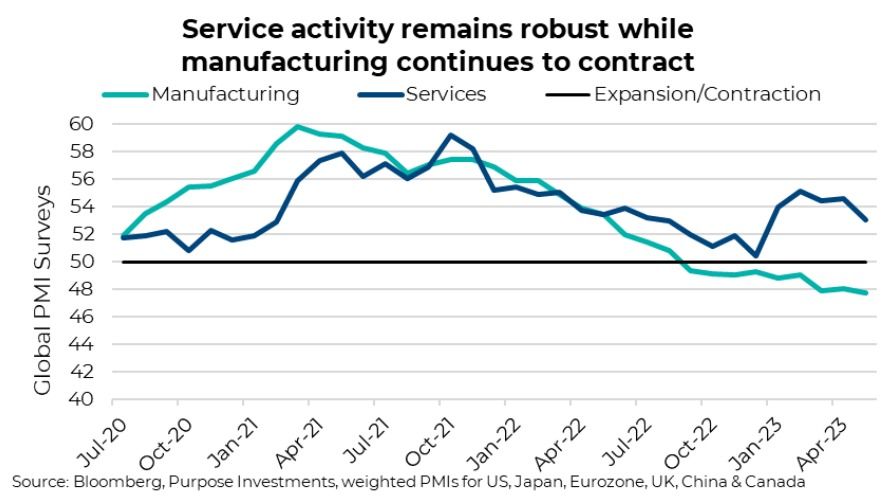
The glass-half-full lens for this data is that overspending on goods during the pandemic and subsequent catching up within supply chains resulted in bringing demand forward into 2020-2021. Normalizing our spending on goods is simply manifesting in less manufacturing activity. This is also evident in other metrics. Trucking demand is way down, given cardboard box shipments are running almost 10% below year-ago levels. Think of those little boxes on your porch. Meanwhile, our desire to travel, eat, and do stuff has services activity rather robust.
The glass-half-empty lens would highlight the fact that changes in manufacturing activity often precede economic activity in the service sectors of the economy. Implying that service activity is at risk of following the trend in manufacturing, providing yet another sign of future slowing in economic activity. Add this to the inverted yield curve, recession probability models and leading indicators.
This divergence of economic activity can also be seen from one economy to the next. China and Germany, which have relatively larger portions of their economy driven by manufacturing, have seen a downturn in data. Meanwhile, economies such as the U.S., which are more service-oriented, have remained more resilient.
What comes next?
Not surprisingly, there are two potential paths (there are probably more than two, but let's simplify). The normalization of goods spending could work itself out and stabilize, with service activity keeping the global economy growing at a reasonable pace. Or all those rate hikes that hit manufacturing/good spending quicker could finally start to weigh on services activity. Bringing on slower economic growth or even recession. We remain in the latter camp but must acknowledge the resilience of the economy or at least that we have once again been a tad early.
Looking at consensus economic forecasts for global economic growth, there is no denying that 2023 is shaping up better than the collective wisdom predicted. Six months ago, forecasts for developed economic growth were barely above zero, and now it has risen to almost 1%. Still a sizeable deceleration from 2022, but at least it isn't negative.
The good news kind of ends there, as forecasts for 2024 have continued to be revised lower for both developed and emerging (developing) economies. Taken at face value, global economic growth still appears set to slow to near stall speed….just later than many had previously expected.
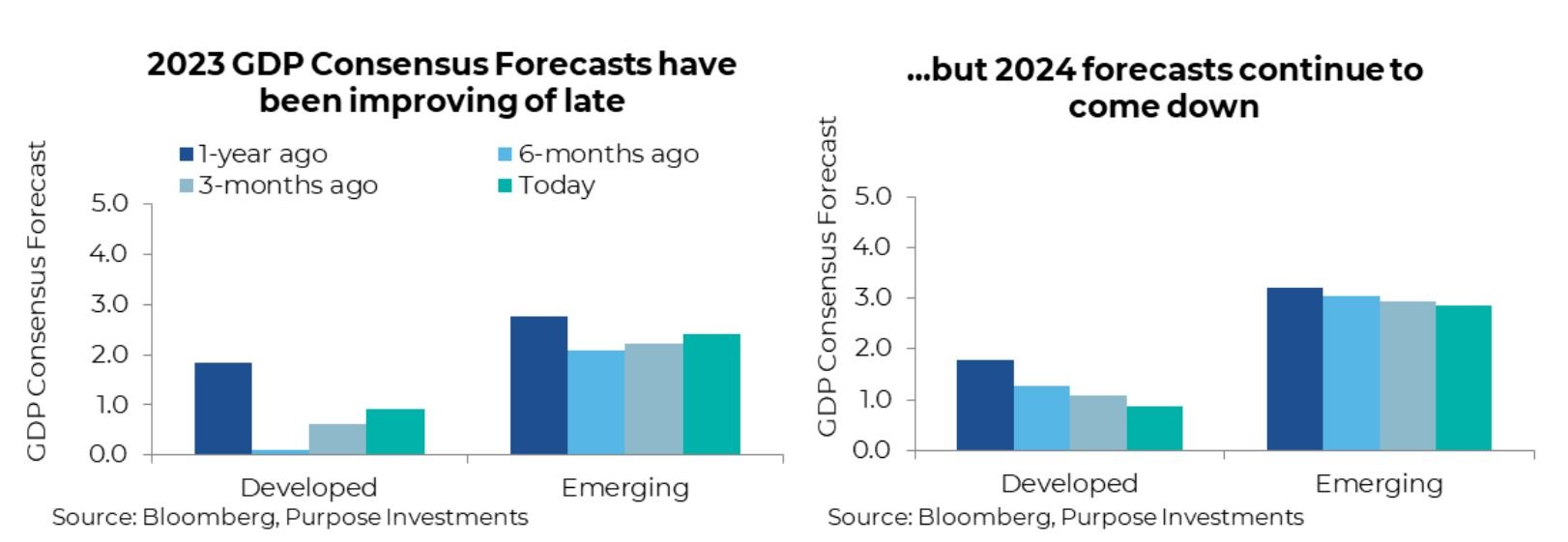
Release Valve and Pressure Cracks
After two months of flirting with the 4,200 level, it was clear this was a major resistance level for the S&P 500. Once released, this pressure point opened the floodgates in June. Aggressive repositioning and short covering from extremely depressed levels on the futures market led to one of the largest weeks of money entering the market over the past five years. Total mutual fund and ETF weekly inflows nearly reached $28 billion mid-month. Lots of fresh new money-long positions have been established as FOMO kicked into high gears. The futures market has also seen a sudden move off some of the most bearish positioning we've seen in the E-mini futures over the past twenty years.
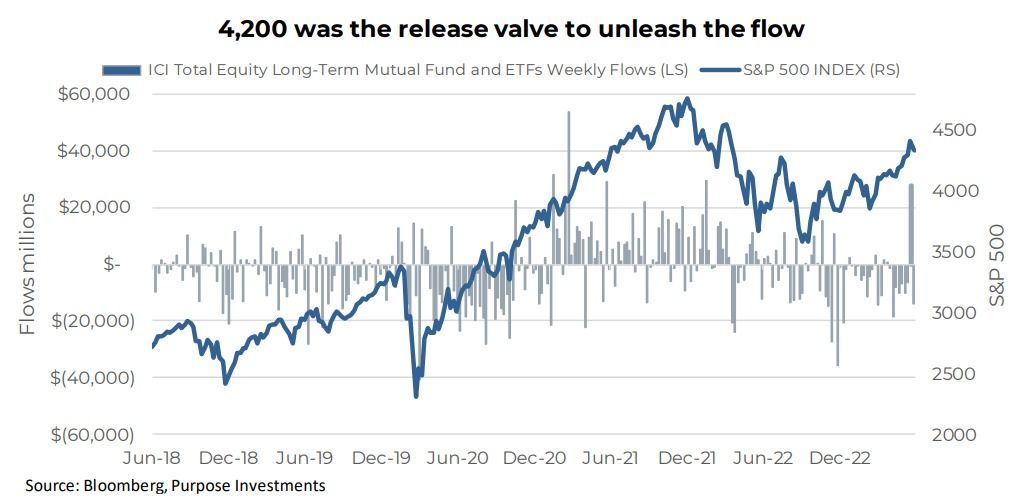
Sentiment has shifted; AAII Bull-Bear reading is now over +20. Not extreme, but any time you have this much of a gap between the bulls and bears, it typically follows some strong returns in the market and is a sign that it is becoming increasingly tilted towards excessive greed. As a contrarian, it's time to take some notice whenever sentiment shifts by such a degree and be ready for a reversal. At this point, it just doesn't seem worth it to jump into the momentum trade from a risk/reward standpoint. Historic flows coupled with stretched sentiment are both signs of pressure cracks building in the market. In addition, the VIX, maybe the most well-known measure of market sentiment. At 14, it's a sign that complacency is abundant in the market.
Predicting isn't easy
It's always hard to make the right call when it comes to forecasting where markets will be in the future. Predictions are difficult, and we'd argue that they are a futile task for several reasons.
- Markets are complex: Financial markets attempt to tie in the complexities of the economy, business valuation, geopolitical events and sentiment every second of the day.
- Uncertainty: Nobody knows what's going to happen in the future. Unforeseen developments can play a major role in market movements. You also have Black Swan events, which are rare and unpredictable events that can disrupt the functions of the market.
- Behavioural: Despite the rise of AI and algos, markets are still largely driven by human factors. With it, they reflect a range of human emotions and all of our wonderful biases.
- Information Asymmetry: The speed and amount of new information that gets disseminated every single day makes it very difficult for strategists to gain any sort of information advantage.
We've been in the recession camp since the beginning of the year. We were not alone. In hindsight, most other strategists had the same idea. The consensus forecasted year-end level for the S&P 500 on January 20th stood at just 4,050. It's since risen to 4,091. Since 1999 there have been very few periods where the market trades through the average year-end forecast for the S&P 500. The fact that the S&P is now nearly 10% over the forecasted level speaks volumes about how fast the recent advance has happened and how widely out of sync the market appears to be with the macro and fundamentals. Besides the stimulus-fueled advance following the pandemic, the spread has never been larger.
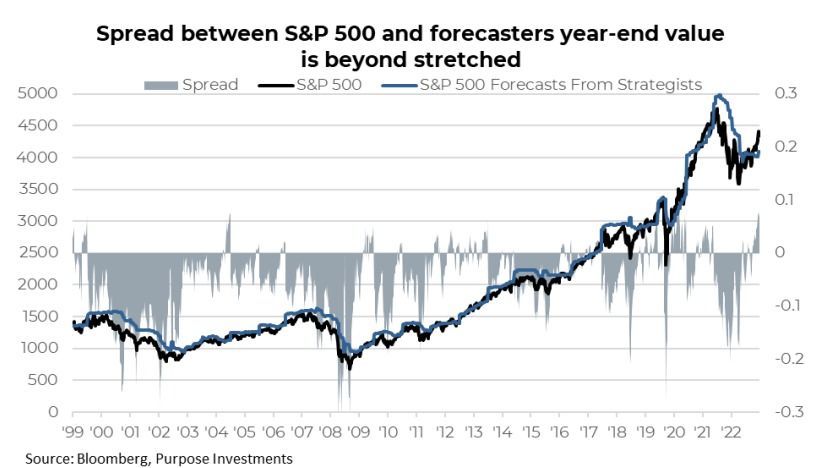
Higher for longer driving divergences
There were multiple themes that took hold during the first half of the year. The return of tech dominance fueled by the AI boom was front and centre, driving the NASDAQ 100 to its best first half on record. What started as the snapback rally off the lows last year, with the biggest losers becoming the biggest winners, gained momentum as everything AI took hold of the market. Rising rates be damned.
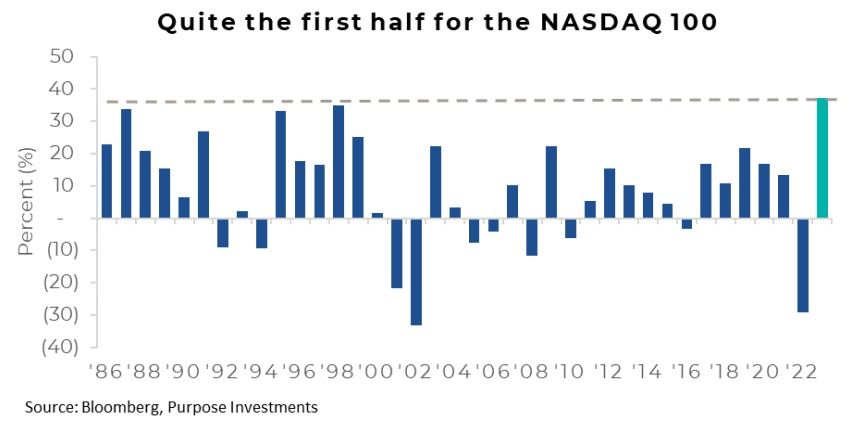
Mega-cap tech companies have broken free of the rising rate handcuffs that restrained the sector in 2022. Unfortunately, not every sector was given the AI key. Central banks have resumed hiking, and there the market is currently expecting more to come. The higher for longer premise has taken a toll on many sectors, in particular Real Estate, Utilities and Telcos. Structural headwinds within parts of the real estate complex, particularly the office sector, remain firmly in place. Infrastructure, especially renewable energy companies, has also faced persistent pressure over the past few quarters. The dislocation across sectors is most evident when comparing cyclical sectors versus defensive sectors. We see the reoccurring K-shape in the graph below, which shows just how disjointed market the market has become. Amidst a murky evolving macro backdrop, spreads between the best and worst-performing sectors over the last three months reached nearly 30% a few weeks ago.

Earnings – Not all negative but certainly paying up for them
Part of this divergence is fundamentally driven. Headline expected EPS for the S&P 500 for 2023 and 2024 has moved slightly higher. In addition, the 3-month change, which was consistently negative for most of last year, is now positive. Though earning expectations have only risen a paltry 1.4%, the rate of change has drastically improved. With recession forecasts being pushed back and/or tempered towards a soft landing, Tech EPS are up a meaningful 12% from their 2023 lows. Likewise, other cyclical sectors have also seen a recent rebound. Defensives, on the other hand, are lagging. With the beginning of the Q2 earnings season set to kick off in a couple of weeks, we'll get a better picture of the winners and losers. Perhaps there is still a lot of wishful thinking in these estimates, especially with the vigorous growth pencilled in a few quarters from now. Earning expectations are still high and not consistent with any type of recession scenario. The market appears to be fully expecting a soft landing followed by a strong recovery. While possible, we still don't see this as a probable scenario given the lagged effects of monetary policy that is set to continue to tighten.
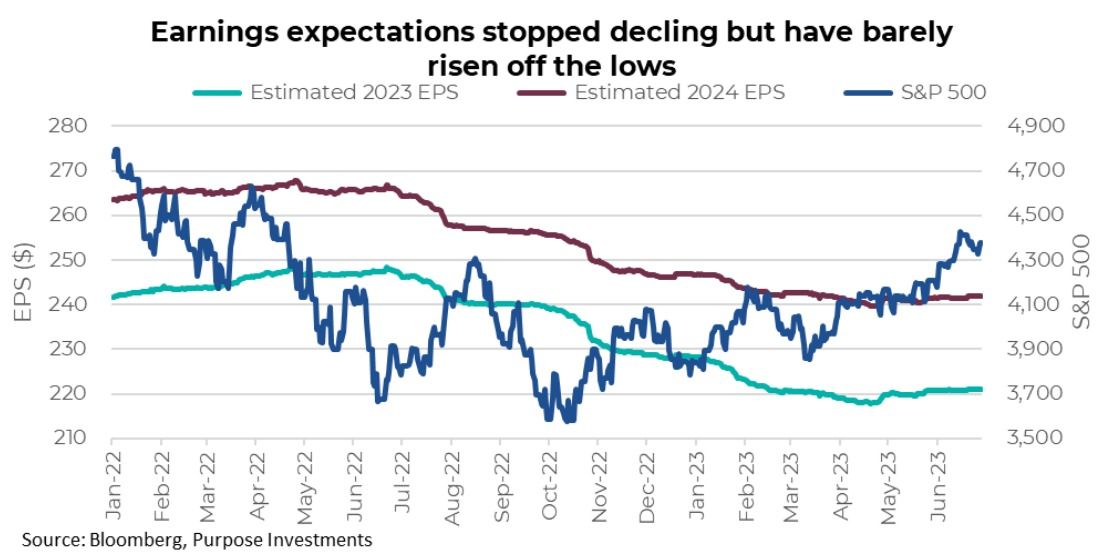
Earnings estimates for the Technology sector have improved, but the market still might have gotten ahead of itself. In the chart below, we have the PE ratio for the S&P 500 Technology index as well as the S&P 500 and the ratio between the two. Valuations for the Technology sector are now 1.4 times higher than the index, which is historically quite stretched. While not quite at 2000 levels where the ratio rose to over two times, investors are clearly paying a high price to gain exposure to AI or the relative safety of fortress-like balance sheets for many of the big tech companies.
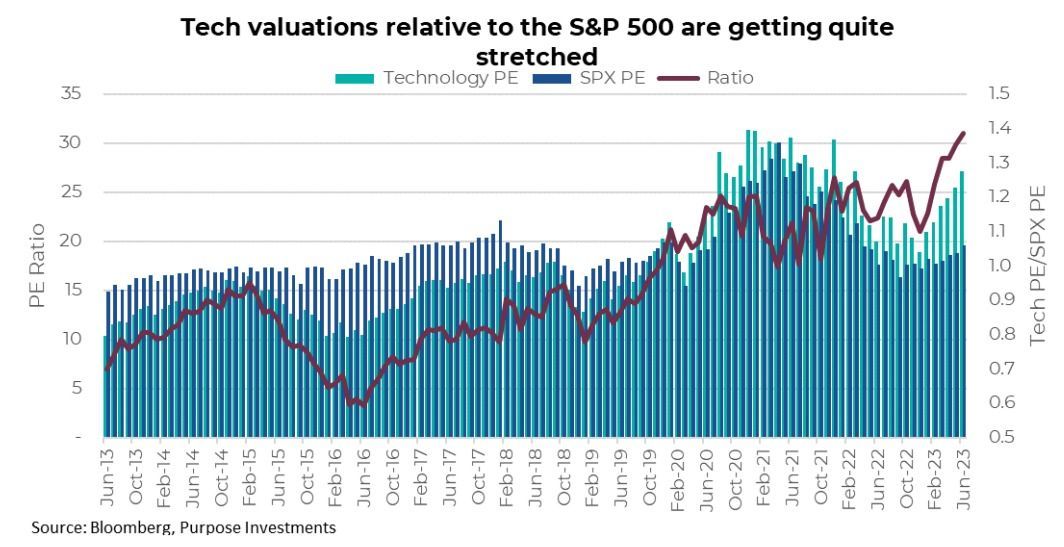
Market Cycle
Directionly 2023 is playing out as expected – it is the magnitudes that are really surprising. Inflation, which remains, is gradually fading as a dominant fear in the marketplace. With peak central bank rates nearby and economic activity remaining surprisingly resilient, the market has continued to rally off the October lows. The S&P has regained 66% of its 2022 losses, the TSX 40%, but those losses were much less. International markets have regained 60% of their previous pain, with some markets reaching all-time highs.
One could conclude the next bull cycle has started, and nobody got the memo. Given the biggest bouncers were the biggest decliners in 2022, we believe this is a bear market bounce, albeit a big one. With credit conditions continuing to tighten, more forward-looking economic indicators rather bearish, and earnings starting to contract, we remain cautious. The drop in 2022 was a valuation decline. After this bounce, we believe a fundamental decline looms.
As a result, we remain moderately tilted towards defence. This translates into a moderate underweight in equities, marginal overweight in bonds and holding elevated cash. Among equities, we have a tilt towards international, market weight in Canada and underweight in the U.S. (unfortunate of late). This is partly valuation driven and some initial positioning for the next cycle, which we believe international will outperform. Bond allocations are lighter on credit, and duration is normal after years of low duration. Our base case is some sort of recession, and duration will once again be a portfolio's friend.
Market cycle indicators have improved a bit but remain below average, warranting our moderate portfolio tilt towards defence. We will remain keenly focused on signs of improvement/deterioration in the manufacturing measures and fundamentals as we enter the Q2 earnings season.
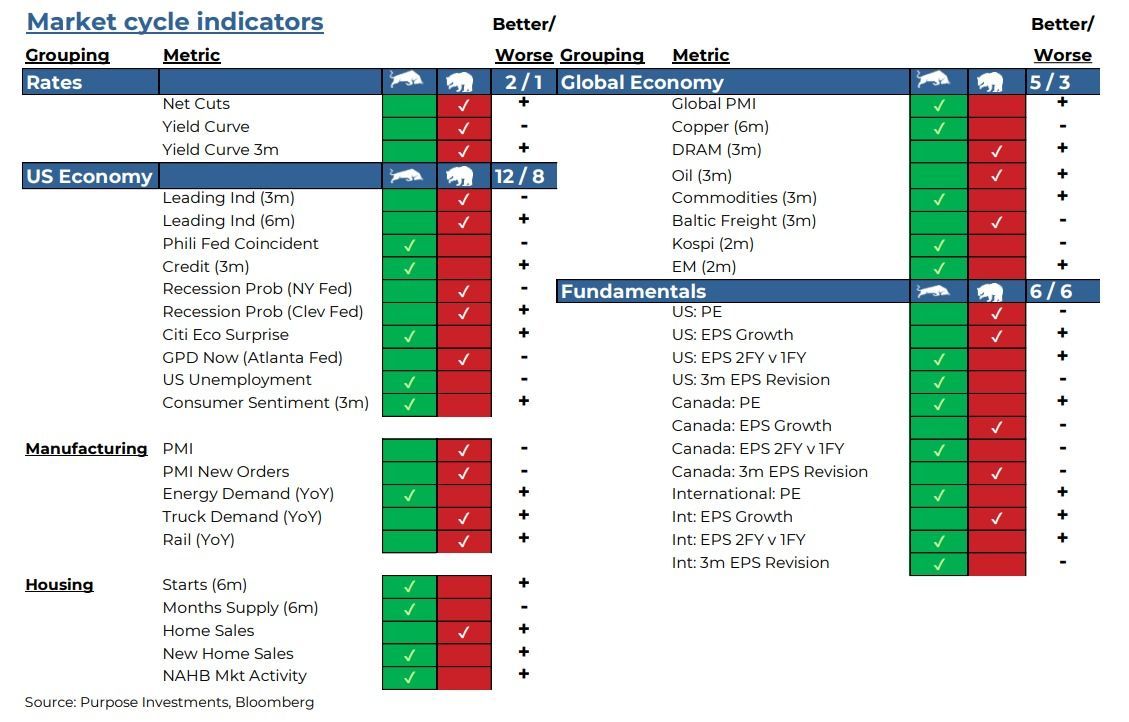
Portfolio Positioning
No changes to our portfolio positioning this past month. We remain with a moderate underweight in equities and a moderate overweight in cash and bonds. Full underweight in emerging markets and moderate overweight in international has worked well of late. The moderate underweight in U.S. equities, not so much.
We continue to find decent value in the more conservative parts of the bond market, given the rise in yields. Again, our fear of duration has fallen as a potential recession is our base case. And among alternatives, we continue to lean on volatility or defence strategies with real assets.

The Final Word
With K-like divergence among different equity markets, within markets depending on cyclicality and defensiveness, among types of economic activity, between different economies and between the market vs forecasts, there is no shortage of mixed signals. This is often a characteristic that becomes prevalent near key turning points. The turning point could be the start of a new bull, but we remain in the camp that it is a potential turn towards an economic or earnings recession.
We continue to lean towards defence but still have enough market exposure in case our conservative mindset proves misplaced.
— Craig Basinger is the Chief Market Strategist at Purpose Investments
— Derek Benedet is a Portfolio Manager at Purpose Investments
— Brett Gustafson is an Analyst at Purpose Investments
Disclaimers
Source: Charts are sourced to Bloomberg L.P. and Purpose Investments Inc.
The contents of this publication were researched, written and produced by Purpose Investments Inc. and are used by Echelon Wealth Partners Inc. for information purposes only.
This report is authored by Craig Basinger, Greg Taylor and Derek Benedet Purpose Investments Inc.
Insurance products and services are offered by life insurance licensed advisors through Chevron Wealth Preservation Inc., a wholly owned subsidiary of Echelon Wealth Partners Inc. This material is provided for general information and is not to be construed as an offer or solicitation for the sale or purchase of life insurance products or securities mentioned herein. Every effort has been made to compile this material from reliable sources however no warranty can be made as to its accuracy or completeness. Before acting on any of the above, please seek individual financial advice based on your personal circumstances. Please note that only Echelon Wealth Partners is a member of CIPF and regulated by IIROC; Chevron Wealth Preservation is not.
Forward-looking statements are based on current expectations, estimates, forecasts and projections based on beliefs and assumptions made by author. These statements involve risks and uncertainties and are not guarantees of future performance or results and no assurance can be given that these estimates and expectations will prove to have been correct, and actual outcomes and results may differ materially from what is expressed, implied or projected in such forward-looking statements.
The opinions expressed in this report are the opinions of the author and readers should not assume they reflect the opinions or recommendations of Echelon Wealth Partners Inc. or its affiliates. Assumptions, opinions and estimates constitute the author’s judgment as of the date of this material and are subject to change without notice. We do not warrant the completeness or accuracy of this material, and it should not be relied upon as such. Before acting on any recommendation, you should consider whether it is suitable for your particular circumstances and, if necessary, seek professional advice. Past performance is not indicative of future results. These estimates and expectations involve risks and uncertainties and are not guarantees of future performance or results and no assurance can be given that these estimates and expectations will prove to have been correct, and actual outcomes and results may differ materially from what is expressed, implied or projected in such forward-looking statements. Echelon Wealth Partners Inc. is a member of the Investment Industry Regulatory Organization of Canada and the Canadian Investor Protection Fund.
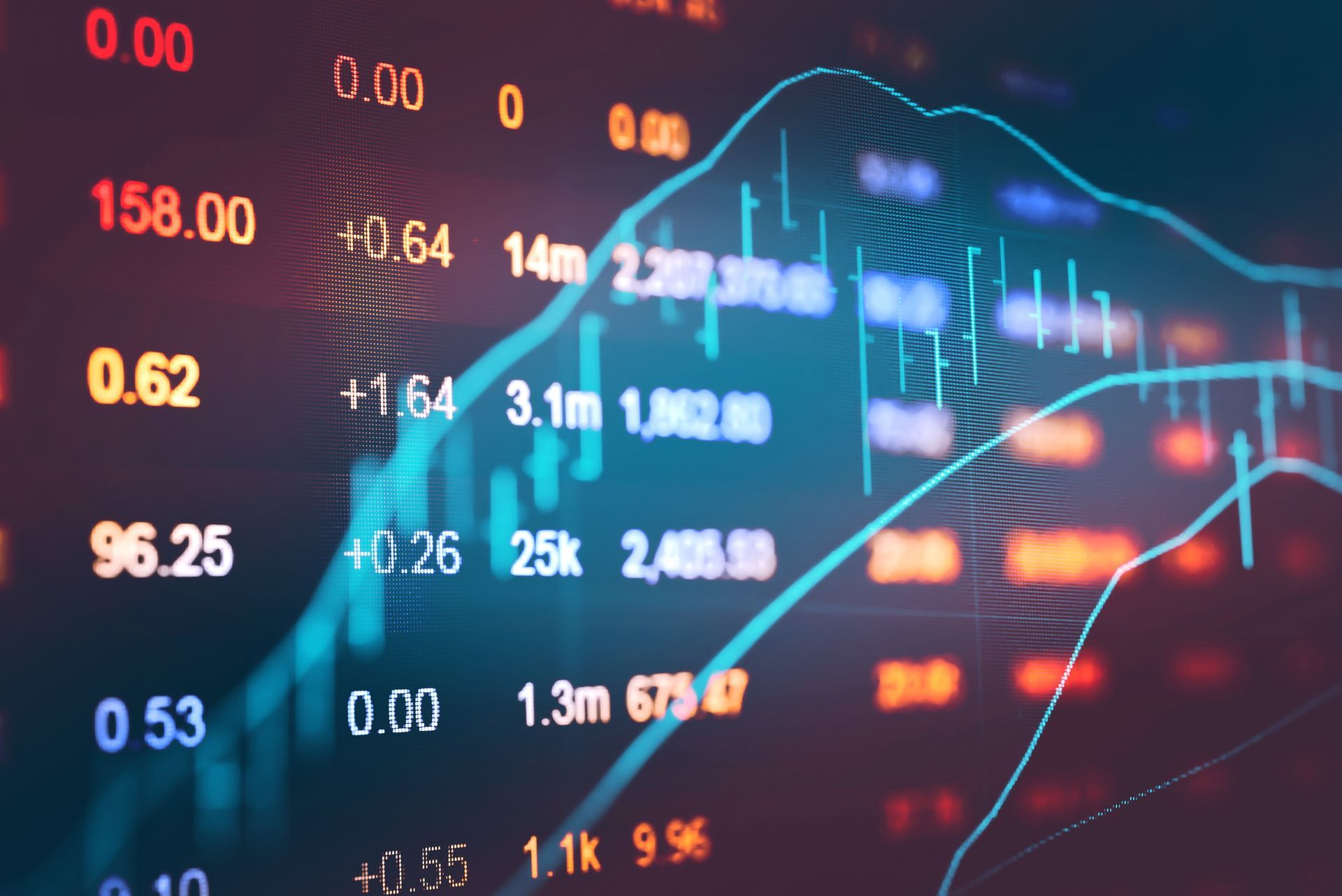


Call our office today for a private consultation about your Beyond Wealth needs.
All Rights Reserved | Ottawa Wealth Management
Please note that only Echelon Wealth Partners is a member of CIPF and regulated by IIROC; Chevron Wealth Preservation Inc. is not. *Insurance Products provided through Chevron Preservation Inc.



